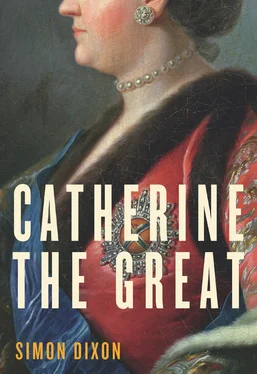18. Sochineniia , xii: 9.
19. Grimm, 88, 16 May 1778.
20. Fulbrook, Piety and Politics , 31; Sochineniia , xii: 10.
21. Sochineniia , xii: 6, 11.
22. Sochineniia , xii: 17; M. Greenleaf, ‘Performing Autobiography: The Multiple Memoirs of Catherine the Great (1756–96)’, Russian Review , 63 (2004), 411–3.
23. Sochineniia , 8–9, (15).
24. Lopatin, 14, C. to Potëmkin, undated.
25. Grimm, 41, 20 Jan. 1776.
26. Grimm, 361, 22 Aug. 1785; O. I. Eliseeva, Perepiska Ekateriny II i G. A. Potemkina perioda vtoroi Russkoi-Turetskoi voiny (1787–1791): Istochnikovedcheskoe issledovanie (M, 1997), 23.
27. Grimm, 212, 8 July 1781.
28. Sochineniia , xii: 19, 6–7. Here C. says her distress was caused by an emotional heroine, whereas in an earlier memoir (p. 441), dating from 1756, she attributes it to a battle scene.
29. Scharf, Katharina II. , 69.
30. Sochineniia , xii: 442.
31. The Memoirs of Charles-Lewis, Baron de Pollnitz , 5 vols. (Dublin, 1738), i: 80.
32. H. Reuther, ‘Das Gebäude der Herzog August Bibliothek zu Wolfenbüttel und ihr Oberbibliothekar Gottfried Wilhelm Leibniz’, in Leibniz: sein Leben, sein Wirken, seine Welt , eds. W. Totok and C. Haase (Hanover, 1966), 349–60.
33. P. Albrecht, et al, Hermann Korb und seine Zeit: Barockes Bauen in Fürstentum Braunschweig-olfenbüttel (Brunswick, 2006), esp. 112–4; H.-H. Grote, Schloss Wolfenbüttel: Residenz der Herzögen zu Braunschweig und Lüneberg (Brunswick, 2005).
34. E. Vehse, Geschichte der Höfe des Hauses Braunschweig in Deutschland und England , 5 vols. (Hamburg, 1853), v: 227–60.
35. Bauer, Die höfische Gesellschaft , 75.
36. Sochineniia , xii: 12–14. In an earlier memoir (p. 442), she claimed to have spent two months of the year in Brunswick.
37. A. Fauchier-Magnan, The Small German Courts in the Eighteenth Century, trans. M. Savill (London, 1958), 27.
38. Ibid., 43, 46, 48, 145, 37 and passim .
39. J. A. Vann, The Making of a State: Württemberg, 1593–1793 (Ithaca, NY, 1984), 190.
40. R. Wilkinson, Louis XIV (London, 2007), 102.
41. H. Watanabe O’Kelly, Court Culture in Dresden: From Renaissance to Baroque (Basingstoke, 2002), 205. See also the magnificent catalogue, Eine gute Figur machen: Kostüm und Fest am Dresdner Hof, eds. C. Schnitzer and P. Hölscher (Dresden, 2000).
42. Vann, Making of a State , 259.
43. The indispensable work is J. Habermas, The Structural Transformation of the Public Sphere , trans. T. Burger (Cambridge, 1989).
44. P. Burke, The Fabrication of Louis XIV (New Haven, 1992), 17–18.
45. T. C. W. Blanning, The Power of Culture and the Culture of Power (Oxford, 2002), 59, is the essential historical commentary on Habermas (see note 43, above).
46. Sochineniia , xii: 24.
47. C. Wolff, Johann Sebastian Bach: The Learned Musician (Oxford, 2000), 187–235.
48. M. Umbach, ‘Visual Culture, Scientific Images and German Small-State Politics in the Late Enlightenment’, Past and Present , 158 (1998), 110–45.
49. H. Dauer, Schloßbaukunst des Barock von Anhalt-Zerbst (Cologne, 1999), 36–95; A. Erdmuter, et al, Anhaltische Schlösser in Geschichte und Kunst (Bindlach, 1994), 88–90.
50. J. Duindam, Vienna and Versailles: The Courts of Europe’s Dynastic Rivals, 1550–1780 (Cambridge, 2003); S. J. Klingensmith, The Utility of Splendor: Ceremony, Social Life, and Architecture at the Court of Bavaria, 1600–1800 (Chicago, 1993).
51. Bauer, Die höfische Gesellschaft , 90–1, attempts tabular comparisons of the major German Courts.
52. A rich cosmopolitan literature can be reached via Princes, Patronage, and the Nobility: The Court at the Beginning of the Modern Age c. 1450–1650 , eds. R. G. Asch and A. M. Birke (Oxford, 1991), and Adamson, ‘Making of the ancien-régime Court’, 7–41. See also H. Smith, ‘Court Studies and the Courts of Early Modern Europe’, Historical Journal , 49, 4 (2006), 1229–38.
53. Sochineniia , xii: 18; Dauer, Schloßbaukunst , 243–50.
54. Sochineniia, xii: 26.
55. Sochineniia , xii: 22–3, 443.
56. Sochineniia , xii: 17–18.
57. Madariaga, 2–4; Bil’basov, i: 13–22, 30–7.
58. Sochineniia , xii: 30; ibid., 443, gives 6 Jan.
59. PCFG, ii: 494–5, Frederick to Johanna Elisabeth, 30 Dec. 1743.
60. Beales, Joseph II , 69–82 (72).
61. Poroshin, 47, 12 Oct. 1764.
62. M. Bregnsbo, ‘Danish Absolutism and Queenship: Louisa, Caroline, Matilda, and Juliana Maria’, in Queenship in Europe: The Role of the Consort 1660–1815 , ed. C. Campell Orr (Cambridge, 2004), 354–5, 357–9.
63. C. C. Noel, ‘“Bárbara succeeds Elizabeth…”: The feminisation and domestication of politics in the Spanish Monarchy, 1701–1759’, in Queenship , ed. Campbell Orr, 155–85.
64. T. Biskup, ‘The Hidden Queen: Elisabeth Christine of Prussia and Hohenzollern Queenship in the Eighteenth Century’, in Queenship , ed. Campbell Orr, 306–9, 313, 315.
65. Sochineniia , xii: 446.
66. Bil’basov, i: 45–6.
67. D. Blackbourn, The conquest of nature: Water, landscape and the making of modern Germany (London, 2006), 22–70 (30).
68. Sochineniia , xii: 446.
69. SIRIO , vii: 1–2.
70. Edward Finch, quoted in J. Black, The British Abroad: The Grand Tour in the Eighteenth Century (Stroud, 2003 edn), 68.
71. Sochineniia , xii: 35; R. J. M. Olson and J. M. Pasachoff, Fire in the Sky: Comets and Meteors, the Decisive Centuries, in British Art and Science (Cambridge, 1998), 49–51.
72. ‘A Letter from the Rev. Mr. Joseph Betts M.A. and Fellow of University College Oxon. To Martin Folkes, Esq.’, Philosophical Transactions of the Royal Society, 1683–1775 , xliii: 94. See also G. Smith, A Treatise of Comets (London, 1744), and Smith’s letter in The Gentleman’s Magazine , xiv: 86, 14 Feb. 1744.
73. S. Schaffer, ‘Comets and the world’s end’, in Predicting the Future , eds. L. Howe and A. Wain (Cambridge, 1993), 52–76; Ryan, Bathhouse at Midnight , 374–5.
74. Correspondance , 1756. The comet of 1757 prompted [F. Aepinus], ‘Razmyshleniia o vozvrate komet, s kratkim izvestiem o nyne iavivsheisia komete’, Ezhemesiachniaia sochineniia (Oct. 1757), 329–48.
75. Poroshin, 265, 29 Aug. 1765.
76. SIRIO , vii: 15.
77. Sochineniia , xii: 36–7; SIRIO , vii: 16–17.
78. E. C. Thaden, Russia’s Western Borderlands, 1710–1870 (Princeton, NJ, 1984), 5, n. 1; Sochineniia , xii: 37.
1. R. Milner-Gulland, ‘16 May 1703: The Petersburg Foundation-Myth’, in Days from the reigns of eighteenth-century Russian rulers, ed. A. Cross (Cambridge, SGECRN, 2007), i: 37–48.
2. Quoted in A. M. Wilson, Diderot (New York, 1972), 645.
3. J. Cracraft, The Petrine Revolution in Russian Architecture (Chicago, IL, 1988), 175–9.
4. F. C. Weber, The Present State of Russia , 2 vols. (London, 1723), i: 297–8.
5. V. Berelowitch, ‘Europe ou Asie? Saint-Pétersbourg dans les relations de voyage occidentaux’, in Le Mirage russe au XVIIIe siècle , eds. S. Karp and L. Wolff (Ferney-Voltaire, 2001), 62–7, esp. p. 66.
Читать дальше












